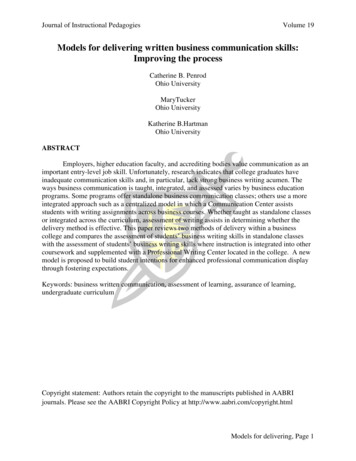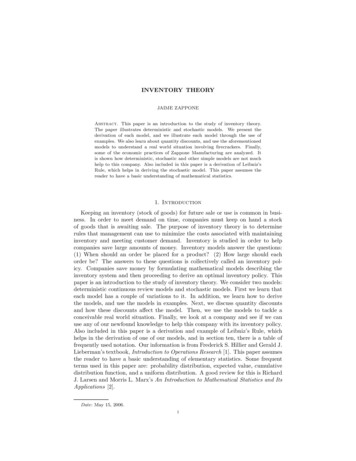
Transcription
Journal of Instructional PedagogiesVolume 19Models for delivering written business communication skills:Improving the processCatherine B. PenrodOhio UniversityMaryTuckerOhio UniversityKatherine B.HartmanOhio UniversityABSTRACTEmployers, higher education faculty, and accrediting bodies value communication as animportant entry-level job skill. Unfortunately, research indicates that college graduates haveinadequate communication skills and, in particular, lack strong business writing acumen. Theways business communication is taught, integrated, and assessed varies by business educationprograms. Some programs offer standalone business communication classes; others use a moreintegrated approach such as a centralized model in which a Communication Center assistsstudents with writing assignments across business courses. Whether taught as standalone classesor integrated across the curriculum, assessment of writing assists in determining whether thedelivery method is effective. This paper reviews two methods of delivery within a businesscollege and compares the assessment of students’ business writing skills in standalone classeswith the assessment of students’ business writing skills where instruction is integrated into othercoursework and supplemented with a Professional Writing Center located in the college. A newmodel is proposed to build student intentions for enhanced professional communication displaythrough fostering expectations.Keywords: business written communication, assessment of learning, assurance of learning,undergraduate curriculumCopyright statement: Authors retain the copyright to the manuscripts published in AABRIjournals. Please see the AABRI Copyright Policy at http://www.aabri.com/copyright.htmlModels for delivering, Page 1
Journal of Instructional PedagogiesVolume 19INTRODUCTION“Writing today is not a frill for the few, but an essential skill for the many” (NCW, 2003).Business graduates entering the workforce today are expected to have professional skills,which include effective writing, speaking, and listening. Employers, higher education faculty,and accrediting bodies value communication as an important entry-level job skill (AACSB,2013; Conrad & Newberry, 2011; Everson, 2014; Hansen & Hansen, 2013; NACE, 2015). Infact, both faculty and employers view communication as the top skill needed in new businessgraduate hires (NACE, 2015).Despite its importance, research indicates that college graduates have inadequatecommunication skills and, in particular, lack strong business writing acumen. In one study, 78percent of employers surveyed ranked business writing skills as one of the top attributes desiredin new business hires; yet employers see this as a skill lacking in today’s graduates (Ghannadian,2013). Dillon (2004) estimated that approximately 3.1 billion is spent annually to trainemployees in professional business writing; of that amount 2.9 billion if dedicated to remedialtraining.Paradoxically, while written communication skills of graduates entering the workforceare judged inadequate, these skills at the same time have become “the ‘gatekeeper’ forindividuals desiring to achieve higher level salaried positions” (NCW, 2004, in Conrad &Newberry, 2011, p. 6). Weak editing skills have been identified as career roadblocks in popularpress, such as Forbes (Conner, 2013), Huffington Post (2015), The Wall Street Journal(Shellenbarger, 2012), and Time (Simonds, 2013). These articles are based on a LinkedIn studyby Grammarly (2013). This research focused on 100 LinkedIn profiles of native Englishspeakers who were employed in the consumer packaged goods industry. The professionalsreviewed had worked for a minimum of three employers in their first 10 years of their career. Ofthe total, half were at the director level or above and the other half were not. Research findingsindicate that: Professionals with fewer grammar errors in their profiles achieved higherpositions. Those who failed to progress to a director-level position within the first 10years of their careers made 2.5 times as many grammar mistakes as their directorlevel colleagues. Fewer grammar errors correlate with more promotions. Professionals with oneto four promotions over their 10-year careers made 45 percent more grammar errorsthan those with six to nine promotions in the same time frame. Fewer grammar errors associate with frequent job changes. Those whoremained at the same company for more than 10 years made 20 percent moregrammar mistakes than those who held six jobs during the same period. (Van Nest,2015, p 1)Grammarly CEO Brad Hoover (2013) asserts that effective writing skills indicatecredibility, professionalism, and accuracy in work, as well as indicate stronger analysis skills(www.grammarly.com). It is important for business communication faculty to implement aModels for delivering, Page 2
Journal of Instructional PedagogiesVolume 19model for teaching communication fundamentals that will assure our students are meeting orexceeding communication expectations during their college years and throughout their careers.DELIVERY METHODSThe way in which business communication is taught, integrated, and assessed vary bybusiness program. Some offer standalone business communication classes (in-person, online, andhybrid); others use a more integrated approach such as a centralized model in which aBusiness/Professional Communication Center assists students with writing assignments acrossbusiness courses. Whether taught as standalone classes or integrated across the curriculum,assessment of writing assists in determining whether the delivery method is effective. This paperreviews two methods of delivery (in-person standalone and in-person integrated moduledelivery) within a business college and compares the assessment of students’ business writingskills in standalone classes with the assessment of students’ business writing skills whereinstruction was integrated into other coursework and supplemented with a ProfessionalCommunication Center located in the college.Standalone Business Communication CoursesThe typical standalone business communication course develops written and verbalcommunication skills, as well as interpersonal, cross-cultural, and employment communicationskills (Moshiri & Cardon 2014). The written skills focus on establishing credibility,understanding your purpose, understanding your audience, and writing a clear, concise,compelling, complete, clean message (in the best format for your intended audience – written orverbal). Students receive instruction and complete assignments to gain understanding and todemonstrate the ability to effectively communicate their message.According to Moshiri & Cardon (2014), business communication instructors’ deliverstandalone courses as traditional, in-person (60.7%), as traditional, in-person and hybrid(36.3%), and as online (3.0%). The number and timing of business communication courses varyby business college. According to a 2013 review of the Top 50 Undergraduate BusinessSchools, 42 of the top schools offered business communication courses. Of those courses,approximately 27 percent were targeted at the freshman/sophomore level and 73 percent weretargeted at the junior/senior level (Sharp & Brumberger, 2013).Communication Modules Integrated into the CurriculumAn alternate approach to a standalone course delivered at a fixed stage in the curriculumsequence is to allocate key communication elements into learning modules that are integratedinto various core courses and taught by a faculty member from a Business/ProfessionalCommunication Center within the college. The modules are designed to address a specificcommunication outcome as well as one-on-one team meetings for guidance and coaching with ajust-in-time delivery approach. The goal is to incorporate writing and presenting throughout thestudents’ time in a College of Business. The combination of communication modules andindividual student/student team meetings is thought to provide students with a clearer connectionbetween the topic and its application.Models for delivering, Page 3
Journal of Instructional PedagogiesVolume 19ASSESSMENT & COMPARISON OF WRITTEN COMMUNCIATION SKILLSRegardless of delivery method, assessment of written communication skills must beconducted to assure student learning. To assess writing skills, a standardized writing rubric thatevaluated the students’ writing in five areas was used. The five areas were: focus & meaning,content & development, organization, language use, voice & style, and mechanics &conventions. The rubric describes expectations for each area necessary to determine whethereach student exceeds expectations, meets expectations, or scores below expectations (full rubricis provided in Appendix A: Writing Rubric). The minimum each student needed to score in acriterion to be classified as meeting expectations was 80 percent. Combined, the desiredoutcome was that 85 percent of students would meet or exceed expectations in each category ofthe writing rubric to effectively demonstrate written communication competencies.Freshman SamplesAssessment of learning for two samples of first year (freshmen) students were compared.Sample 1 included first-year students enrolled in a standalone Business Communication course.This course was a four-credit hour freshman level course that introduced basic businesscommunication principles and practices and set the communication standards in preparation forreal-world workplace experiences. The course used business related cases for research, writing,and speaking activities. Some attention was also given to internship preparation, specificallycover letter and resume writing. The sample included 77 students – 24 freshmen, 46 sophomores,5 juniors, and 2 seniors. The artifact used to assess learning was a self-assessment memo writtenas a reflection and application of a class activity. Specifically, after a communication styletraining session, each student was asked to write three paragraphs that individually summarizedwhat s/he learned about his/her communication style, critically evaluate the theory, anddiscussion hypothetical applications of the theory.Sample 2 included first-year students enrolled in a three-credit hour introduction tobusiness course, which included a general introduction to business, its environment, and theskills needed for success. The sample included 157 students – 92 freshmen, 47 sophomores, 21juniors, and 9 seniors. Unlike students enrolled in the standalone course, these studentsparticipated in modules that were integrated into a functional knowledge course they took eitherprior to or at the same time as this course. However, like the standalone course, students wereprovided instruction in The Basic of Business Writing, The Basics of Business Presentations, andWriting Cover Letters and Resumes. The artifact used to assess learning from the moduledelivery was reflection memo. Both samples were taught by the same instructor and wereassessed by the same assessor.For both samples, the same assessment instrument was used to assess the writing of thisgroup of students and is available for review in Appendix A. The minimum each student neededto score in a criterion to be classified as meeting expectations was 80 percent. The same desiredoutcome (i.e., 85% of students would meet or exceed expectations in each criterion) was used bythe assessor. Table 1 provides the assurance of learning assessment results for each sample.Models for delivering, Page 4
Journal of Instructional PedagogiesVolume 19Table 1: Assessment Results at the Freshman LevelCriteriaFocus & MeaningContent & DevelopmentOrganizationLanguage Use, Voice & StyleMechanics & ConventionsMeets or Exceeds ExpectationsSample 1:Sample 2:Standalone CourseIntegrated Delivery89%94%83%87%89%76%83%83%72%76%1 vs 2:Difference-5%-4% 13%0%-4%For the freshman-level standalone course, the results achieved the desired outcome fortwo of the five criteria: Focus & Meaning and Organization. For the integrated delivery, theresults achieved the desired outcome for two of the five criteria: Focus & Meaning and Content& Development. Comparing the two samples, students enrolled in the standalone course didsignificantly better than students taught using modules as part of the integrated delivery forOrganization (z 2.50, p 0.05). Differences between the samples for the other four criteriawere not significantly different, p 0.05. It is important to note that students did not meetexpectations for language use, voice, style, mechanics, and conventions in either delivery mode.Senior SamplesAssurance of learning results for two samples of fourth years (seniors) were alsocompared. For both samples, students did not receive any Business Communication instructionas part of the course in which the assessment took place. The students in Sample 1 had taken thebusiness standalone course during their first (freshmen) year. Comparatively, students in Sample2 were students exposed to Business Communication as learning modules integrated intodiscipline-based courses during their first and second years.Sample 1 included 106 students – all senior business majors. Sample 2 included 108students – all senior business majors. For both samples, the artifact used for the analysis was anindustry analysis formal report. Each student analyzed 3-4 companies in a specified industryusing various performance ratios and produced a written analysis with a 10-page maximum pagelimit. Both samples were taught by the same instructor and were assessed by the same assessor.For both samples, the same assessment instrument was used to assess the writing of thisgroup of students and is available for review in Appendix A. The minimum each student neededto score in a criterion to be classified as meeting expectations was 80 percent. The same desiredoutcome (i.e., 85% of students would meet or exceed expectations in each criterion) was used bythe assessor. Table 2 provides the assurance of learning assessment results for each sample.Models for delivering, Page 5
Journal of Instructional PedagogiesVolume 19Table 2: Assessment Results at the Senior LevelMeets or Exceeds ExpectationsCriteriaFocus & MeaningContent & DevelopmentOrganizationLanguage Use, Voice & StyleMechanics & ConventionsSample 192%92%83%99%50%Sample 281%86%67%85%41%1 vs 2:Difference 11% 6% 16% 14% 9%For Sample 1, the results indicate that the desired outcome was reached for three of thefive criteria: Focus & Meaning, Content & Development, and Organization. For Sample 2, theresults achieved the desired outcome for two of the five criteria: Content & Development andLanguage Use, Voice, & Style. Comparing the two samples, students in Sample 1 didsignificantly better than students in Sample 2 for Focus & Meaning (z 2.54, p 0.05),Organization (z 2.75, p 0.05), and Language Use, Voice, & Style (z 3.75, p 0.05). Therewere no significant differences in Content & Development or Mechanics & Conventions, p 0.05. Unfortunately, students did not meet expectations for Organization, or Mechanics &Conventions in either sample.DISCUSSIONExamined in the aggregate, the results suggest three preliminary insights about teachingand learning business communication skills. First, at the beginning of a business program (firstyear), neither standalone business communication courses or learning modules integrated indiscipline-based business courses successfully achieved desired learning outcomes. Althoughstudents exposed to business communications through a standalone demonstrated betterorganization skills than students exposed to business communication as part of a discipline-basedcourse, first year students in both samples did not meet expectations for two of the five criteria:Language Use, Voice, & Style and Mechanics & Conventions.Second, students did not consistently improve between the first and fourth year of thecurriculum in either delivery method. Comparing assessments results between the first andfourth year for the sample who took the standalone course, there were no significant differencesfor three of the five criteria: Focus & Meaning ( 3%), Content & Development ( 9%), andOrganization (-6%), p 0.05. By contrast, Language Use, Voice, & Style improved 16% (z 4.01, p 0.05) while Mechanics & Conventions decreased 22% (z -2.91, p 0.05).Comparing assessments results between the first and fourth year for students who did not takethe standalone course, there were no significant differences for three of the five criteria: Content& Development (-1%), Organization (-9%), and Language Use, Voice, & Style ( 2%), p 0.05.By contrast, Focus & Meaning decreased 13% (z -3.46, p 0.05) mechanics & conventionsdecreased 35% (z -5.76, p 0.05).Third, and most importantly, neither of the models achieved the desired outcome of 85percent of students meeting or exceeding expectations in mechanics & conventions across any ofthe samples. The results lead to the question of why students do not seem to demonstrate theModels for delivering, Page 6
Journal of Instructional PedagogiesVolume 19ability to use mechanics & conventions effectively. What is the missing element to connect theteaching of the skills to the demonstration of the skills on an ongoing basis?Arguably, one plausible explanation for the consistently low assessment results is thatbusiness communications require students to be continuously exposed to and held accountable toa level of expectations. Unlike the other criteria for writing, one could argue that Mechanics &Conventions – as the “rules of writing” – are generally discipline-free and require both trainingand practice. Perhaps considered the boring parts of learning to write effectively, Mechanics &Conventions are the basic foundations of effective communications. As such, faculty must setand adhere to expectations for student writing assignments. These expectations are based onstudent accountability and exposure to the principles of effective writing as depicted in Figure 2.Figure 2: Proposed ModelBuildExpectationsAccountabilityFatal Error PolicyWriting QualityImpacts onsw/PeersFigure 2 provides a proposed model for building expectations based upon two distinctteaching activities: exposure and accountability. In terms of exposure, students should besystematically and deliberately exposed to writing standards as part of the learning process.Examples include standalone courses, modules integrated into other types of courses, and writingreviews with peers. Exposure is important to both provide opportunities for learning and toremind students about writing standards. In terms of accountability, students should be heldaccountable for their ability to adhere to writing standards as a component of the gradingprocess.One example is implementing a fatal error policy, which may include identifying amaximum threshold for certain writing errors (e.g., misspellings, sentence fragments, run-onsentences, use of paragraphs, capitalizations, etc.) and either failing student work or returningstudent work for revision if the maximum threshold is exceeded. Another example is accountingfor writing quality as a substantial percentage of the evaluation of the assignment. Arguably, thepercentage should be high enough to motivate students to adhere to writing standards. For bothexamples, accountability involves evaluations of student work framed as either a punishment or areward. Combined, exposure and accountability may function concurrently to improve writingquality. Future research should explore this model in more detail and conduct assessments todetermine if its implementation changes the assessment outcomes.Models for delivering, Page 7
Journal of Instructional PedagogiesVolume 19LIMITATIONS AND FUTURE RESEARCHAs with any study, there are some limitations that should be carefully considered. First,samples were limited to a single business program at the same university. Future research shouldcompare students across university settings and programs. Second, although the sampleelements in the first and fourth year samples overlapped significantly, the first and fourth yearsamples were not matched pairwise. Future research should track students longitudinally toassess learning across an entire program. Third, only direct assessments of writing wereevaluated. Future research should explore students’ self-reports of learning including confidencein abilities, perceived skill development, and attitudes toward writing.CONCLUSIONUsing student samples, this study compared assessments of students’ business writingskills from two distinct instructional methods: using a standalone business communicationscourse and using modules integrated into other coursework. The results of the comparisons aremixed; neither methods of delivery produced the desired levels of achievement during thebeginning of the program (i.e., first year) or at the end of the program (i.e., fourth year). Inaddition, students did not consistently improve between the first and fourth year of thecurriculum in either delivery method. As such, future research should explore other mechanisms– such as accountability – in conjunction with methods of knowledge delivery. At a time whenour graduates’ careers are so dependent on professional communication abilities, implementing awinning model of business communication instruction is most critical. Finding that model isimperative.REFERENCESAACSB International (The Association to Advance Collegiate Schools of Business). (2015).Eligibility Procedures and Accreditation Standards for Business Accreditation.[Electronic version]. Retrieved October 29, 2015, fromhttp://www.aacsb.edu/ standards-update-jan2015.ashxConner, C. (2013). Report: How grammar influences your income. Forbes. Retrieved November8, 2015 from http://www.forbes.com/.Conrad, D., & Newbery, R. (2011). 24 Business communication skills: Attitudes of humanresource managers versus business educators. American Communication Journal, 13:1, 423.Dillon, S. (2004, December 7). What corporate American can't build: A sentence. The New YorkTimes.Everson, K. (2014). Chief Learning Officer, 18-21, 46.Ghannadian, F. (2013, March/April). What employers want, what we teach. BizEd, pp. 40-44.Grammarly. (2013). Good grammar will get you promoted. Retrieved November 8, 2015 sen, R. S., & Hansen, K. (2013). What do employers really want? Retrieved from:www.quintcareers.com/job skills values.html.Models for delivering, Page 8
Journal of Instructional PedagogiesVolume 19Huffington Post. (2015). Think grammar doesn’t matter? It could be holding you back from apromotion. Retrieved on November 8, 2015, from http://www.huffingtonpost.com/.Moshiri, F., & Cardon, P. (2014). The state of business communication classes: A nationalsurvey. Business and Professional Communication Quarterly. 77(3) 312-329.NACE (National Association of Colleges and Employers). (2013). Retrieved October 29, 2015,from s-quality.aspxNCW (The National Commission on Writing in America’s Schools and Colleges). (2003). TheNeglected “R”, The need for a writing revolution. The College Board.NCW (The National Commission on Writing in America’s Schools and Colleges). (2004).Writing: A ticket to work or a ticket out. The College Board.Sharp, M., & Brumberber, E. (2013). Business communication curricula today: Revisiting thetop 50 undergraduate business schools. Business Communication Quarterly. 76(1) 5-27.Shellenbarger, S. (2012). This embarrasses you and I* Grammar gaffes invade the office in anage of informal email, texting and Twitter. The Wall Street Journal. Retrieved November8, 2015, from: http://www.wsj.com/articles/.VanNest, A. (2015). Grammar mistakes on your linkedin profile can stunt your career. RetrievedNovember 8, 2015, from: http//:blog.hubspot.com/.Models for delivering, Page 9
Journal of Instructional PedagogiesVolume 19APPENDIX A: ASSESSMENT INSTRUMENTModels for delivering, Page 10
skills in standalone classes with the assessment of students’ business writing skills where instruction was integrated into other coursework and supplemented with a Professional Communication Center located in the college. Standalone Business Communication Courses The typical standalone business










